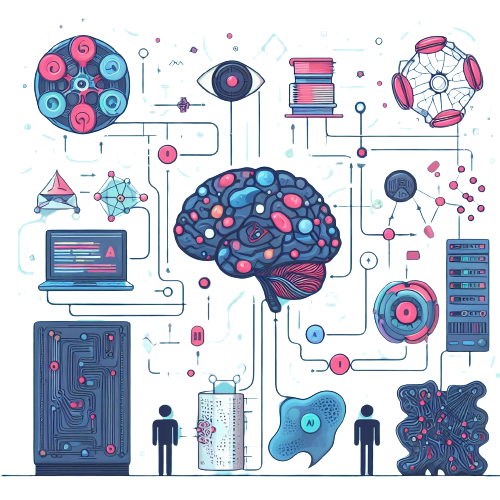Common Terms in ML and AI

A concise glossary of common terms encountered in the realm of Machine Learning (ML) and Artificial Intelligence (AI), including Algorithm, Supervised Learning, Unsupervised Learning, Reinforcement Learning, Epoch, Overfitting, Backpropagation, Activation Function, Loss Function, Gradient Descent, Convolutional Neural Networks, Recurrent Neural Networks, Transfer Learning, Bias in AI, and Generative Adversarial Networks.
Welcome to a concise guide on some of the fundamental terms and concepts in the realm of Machine Learning and Artificial Intelligence. As these technologies continue to shape our world and future, understanding the basics becomes crucial. Dive in to unravel the layers of this technological marvel.
Algorithm #
In the AI world, an algorithm is like a recipe for a dish. It's a set of instructions or guidelines that, when followed, help achieve a particular outcome. It tells the machine, step by step, how to solve a problem or make a decision based on data.
Supervised Learning #
Imagine teaching a child to differentiate between fruits by showing them images of apples and saying "this is an apple". Supervised Learning is similar. The model is provided with input-output pairs, and it learns to map the relationship between them.
Unsupervised Learning #
Now, imagine giving a child a bunch of different toys without naming them and asking them to group similar ones together. That's Unsupervised Learning. The model identifies patterns and structures in the data without any labeled responses to guide the learning process.
Reinforcement Learning #
Picture training a dog: it performs an action, and based on that action, it gets a treat (reward) or no treat (penalty). Reinforcement Learning is about training models using rewards and penalties, helping them learn how to behave in an environment to maximize some notion of cumulative reward.
Epoch #
In training sessions, just as a student might go through a textbook multiple times to thoroughly understand the content, machines go through the dataset multiple times. Each complete pass through the entire dataset is called an "epoch".
Overfitting #
Imagine a student who memorizes all questions and answers from a textbook, but fails when posed with a slightly different question in the exam. Overfitting is similar. A model learns the training data too well, including its noise and irregularities, and performs poorly on new, unseen data.
Backpropagation #
Think of it as a feedback system in a class. If a student answers a question incorrectly, the teacher indicates where they went wrong and explains the correct answer. Similarly, backpropagation adjusts the model's weights based on the error in its prediction.
Activation Function #
In a choir, each singer decides when to sing loudly, softly, or not at all, based on the song's requirements. In a similar vein, the activation function in a neural network decides how much signal to pass onto the next layer.
Loss Function #
Imagine a golf game where the aim is to get the ball into the hole in the fewest strokes. The "strokes over par" can be seen as the error. In AI, the loss function measures the difference between the model's predictions and the actual values, much like "strokes over par" in golf.
Gradient Descent #
If you've ever been in a maze, finding the exit involves trying different paths and avoiding dead ends. Gradient Descent is the maze-solving method for machines. It helps in adjusting the model's parameters to minimize the error or "loss".
Recurrent Neural Networks (RNN) #
A type of neural network where outputs from previous steps are fed back into the network.
Transfer Learning #
Using a pre-trained model (a model trained on a large dataset) as a starting point and retraining it on a new, smaller dataset.
Bias (in AI) #
Just as humans can have biases, leading them to have a skewed view of the world, AI systems can also exhibit bias in their outputs, often reflecting prejudices present in their training data or in the way they were designed.
GAN (Generative Adversarial Network) #
Imagine two artists – one trying to create a forgery of a famous painting, and another trying to detect which one's the fake. They continuously challenge and learn from each other. In GANs, the two "artists" are the "generator" (creating data) and the "discriminator" (evaluating data).
These are just some foundational terms, and the field is vast and constantly evolving. Each term can be explored in depth, but this should give you a good starting point!
As you delve deeper, you'll find that these concepts are just the tip of the iceberg. However, understanding these foundational terms will give you a solid footing in the vast and dynamic world of AI and ML.
